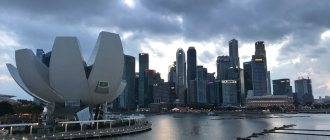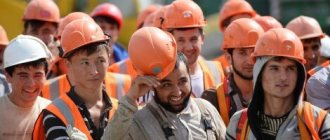Almost every Russian spends a certain amount of time every day going to work in the morning and getting from his workplace to his home in the evening. Such a simple and ordinary procedure, in fact, hides a whole concept called pendulum migration.
Dear readers! The article talks about typical ways to resolve legal issues, but each case is individual. If you want to find out how to solve your particular problem , contact a consultant:
8 (800) 700 95 53
APPLICATIONS AND CALLS ARE ACCEPTED 24/7 and 7 days a week.
It's fast and FREE !
Few people think about the importance of revealing this concept and developing this migration for progress in the country as a whole. Let's consider the issue of the manifestation of pendulum migration, and also try to understand its importance for Russians in general.
What is
Pendulum migration is the constant movement of masses of people from one locality to another to complete a work shift or training. The constancy of this phenomenon fully corresponds to the regime of work and training.
The emergence of this phenomenon was marked by the intensification of the urbanization process in the state. At the same time, the basis of this phenomenon is the discrepancy between the placement of industrial premises and the settlement of civilians.
The main direction of migration today is the “urban-rural” type. Migration of this type is a source for the formation of labor resources in urban areas. This phenomenon can also ensure a balanced and acceptable use of labor resources in large cities and rural areas.
Commutative migration can act as an optimizer for creating equal conditions for the ideal choice of a place of education for citizens according to their qualifications or work.
In addition, this phenomenon contributes to the development of such features as:
- Spread of urbanization.
- Social mobility.
- Changes for rural residents of the social structure.
- Overcoming some of the differences between urban and rural settings.
What is pendulum migration
Commutative migration is a type of territorial movement of citizens from one locality to another to work or to study. The term “pendulum migration” was applied to such movements due to the external similarity of the processes. The phenomenon resembles the movement of a pendulum: in the morning masses of people go to another settlement to work, and in the evening they return home.
Signs of pendulum migration
The essence of pendulum migration is determined by several features that distinguish it from other types of migration processes. These include:
- Regularity - movements are characterized by frequent, almost daily trips;
- Duration - movements occur over a long period of time;
- No change of residence - citizens do not change their place of residence.
Differences from other types of migration
Such movement has serious differences from other migration processes. Migration is the relocation of citizens to a new place of residence on a temporary or permanent basis. With pendulum migration, relocation does not occur: citizens remain to live in their settlement.

This is its main difference from other types of migration:
- Temporary , in which a person moves for a limited period of time, but his permanent place of residence does not change;
- Seasonal - a type of temporary migration, closely related to a certain season and aimed at carrying out harvesting work, etc.;
- Irregular , episodic in nature.
Peculiarities
It is common for every person to spend a lot of time getting to work and back. This happens due to economic considerations. Sources for large earnings are usually always concentrated in the centers of megacities. At the same time, residential areas have a higher cost than in residential areas.
The larger the city, the more developed it is. In some situations, the city has exhausted its resources favoring the creation of secondary work sites.
A similar opportunity may arise in the suburbs, since often there are no enterprises or shops there that form a favorable infrastructure.
The movement, initially directed towards the center, will be turned back. Experts are currently observing two flows going opposite each other - one is directed to the center, and the second to the residential area.
In this case, the polarity between the city center and the residential area will decrease, and thanks to this phenomenon, the suburb acts as a small center that attracts the main working bridges.
Stages of development of pendulum migration
At the initial stages of development of agglomerations, especially those that have a pronounced hypertrophy of the center, daily pendulum migration is directed mainly from residential areas and satellite cities to the historical center (core) of the city. However, as the resource potential of the core is exhausted, the growth of suburbanization processes, the development of peripheral infrastructure, the increase in the level of population and economic specialization of the outskirts, and the growing level of self-sufficiency of satellite cities, a reverse flow appears: residents of the highly urbanized core begin to participate in pendulum migration to the periphery. Thus, two counter flows arise.
Moscow agglomeration
According to studies on the topic of commuting migration, at the beginning of 2000, 800-850 thousand people came to Moscow from the region every day to work or study, while 200-250 thousand were sent to the region from the capital[2]. Thus, the total turnover of commuting migration in the Moscow agglomeration exceeded 1 million people already in the early 2000s. In 2010, the positive balance of labor commuting migration in Moscow reached 1.8 million people per day, and a significant contribution to it was made not only by residents of the Moscow region, but also by other immediate neighboring regions - Tula, Vladimir and Kaluga regions[3].
Kyiv agglomeration
According to KSCA estimates, daily commuting migration to Kyiv in 2016 was about 300 thousand people per day[4]. Most of it is provided by neighboring cities (Brovary, Vyshgorod, Boryspil and others). The counter flow from the city to the region is poorly developed due to the relative sparse population of the Kyiv region.
For the Kyiv agglomeration, as well as for Kiev itself, the discrepancy between the right and left bank parts has become common: almost 80% of the city’s jobs are located on the right bank, and more than 40% of housing (including most of the cheap housing) is on the left. Already in the 1970s, Kiev had a plan to create its own business center for the left bank part of the agglomeration, but it, like all subsequent ones, was never realized. Therefore, in the agglomeration, the issue of population movement between the two banks and, accordingly, the insufficiently high capacity of bridges is quite acute. Some discrepancies in transport accessibility have also increased: for example, getting to Khreschatyk from the city of Brovary is faster than from the outskirts of the capital itself. At the same time, the processes of suburbanization, at least in their Western understanding, are still rather weakly expressed, since further compaction and verticalization of the agglomeration center is taking place. In the 2000s, the bloc fragmentation of the Soviet period only intensified and reached a mosaic level.
Reasons for pendulum migration
During the absence of cars and other civilizational advantages, Russian citizens tried to live close to their work. There was no other way out for these individuals.
But with the advent of transport, people had the opportunity to live outside the city and come to it only to work. Due to the absence of restrictions, the number of labor in the city from local citizens increased. Accordingly, the city grew and expanded.
Additional jobs appeared, which were then occupied by residents of the suburbs and villages. This is how residential areas appeared, where there were exclusively residential buildings and there were no enterprises or organizations. After this, the cities grew in different directions and in this way large metropolises appeared.
This phenomenon became more widespread by the beginning of the 21st century.
At the moment, anyone living in a big city is well aware that pendulum migration exists. This is what is called the daily movement of people from their own home to their place of study or work.
The difference between pendulum migration and regular migration is the fact that the process takes place without changing permanent residence. This phenomenon has no effect on population changes.
Reasons for origin
Previously, when there were no cars, trains and other benefits of civilization, people lived near their work or worked near their home - as you liked. Because they simply had no other choice. But then transport appeared, and the worker gained the opportunity to live not in the center, but in the suburbs or even in a neighboring village, and come to the city only to work, and return back in the evening.
Thanks to the fact that now the number of workers in the city was not limited only to local residents, the city had the opportunity to grow. New jobs appeared that were occupied by residents of the suburbs - this is how residential areas appeared, where there were practically no enterprises - only residential buildings. Cities grew wider on the periphery and higher in the center - megacities appeared.
By the beginning of the 21st century, this phenomenon had become widespread.
Now every resident of a big city knows what commuting migration is - this is a regular, most often daily movement of the population to the place of work or study and back.
Unlike ordinary migration, it takes place without changing permanent residence and does not affect the total population in the region.
Examples
The main example for pendulum migration is a situation in which a large mass of people goes to work from one area to another. This phenomenon occurs in any large or small city that has municipal areas.
In addition, rotational work can be classified as pendulum migration. In such a situation, people come to another city from one to work for a certain period of time in it. This type of migration differs from the standard one only in the period for work.
The rotation method involves changing your place of residence for a month, 3 months, six months and other times.
Also, an example of pendulum migration can be moving to study in another area or even country. In the first case, the student undergoes training for a certain period of time, after which he will return to his usual place of residence to work.
In particular, this example is typical for training that is carried out in the target area.
See how to register for a personalized account with a pension fund. How is the disability pension paid? Find it at the link.
Problems
The most global problem for commuter migration is the lack of conveniences for moving to other settlements. Not every Russian region has a convenient transport interchange and therefore citizens have to spend much more time getting to their work.
As a result, people may be late for work and problems arise with the management of their enterprise.
In addition, people do not always have the opportunity to find a good job due to their unpreparedness to move to a new area, or when the workplace is very far from their home and the person does not have personal transport.
In such cases, employers provide places in specialized dormitories for their workers, but not every organization can use this practice.
Also, one of the main problems for Russians is the large amount of money spent on travel. If the enterprise has rotational transportation, then citizens may not complain, because everything happens in a timely manner and there are no costs.
However, if a person has his own car, then a fairly high percentage of his salary goes to fuel.
Problems of pendulum migration
The article discusses the issues of pendulum migration: the influence of this process on the development of large and small cities. The factors that determine the level of commuting migration in a small locality are also analyzed using the example of Sosnovy Bor.
Key words:
commuting migration, labor resources, unemployment, mobility
.
The article discusses the impact of circular migration process in the development of cities and towns.
Also, it analyzes the factors determining the level of commuting in a small village like Sosnovy Bor.
Keywords:
circular migration , workforce, unemployment, mobility.
In a broad sense, migration is associated with the movement of people from one region (country) to another in order to find new opportunities and improve the quality of life. It is accompanied by crossing both the external borders of the state and the internal borders of administrative-territorial entities [1].
Migration affects all regions of the world, and many countries today are simultaneously countries of origin, destination and transit. Having finished with the designation of the very concept of migration, I would like to move on to consider a narrower problem inherent in modern Russia - this is the problem of pendulum migration. This process emerged and developed during the period of urbanization, when the gap between urban and rural cultures became most obvious. If earlier, before the growth of industry in the cities, people in Russia were mainly engaged in subsistence farming, then after the advent of tractors and machines, labor productivity increased several times, and the need for human hands decreased. People in search of work began to travel to nearby cities to feed their families. The role of the city in the development of society has increased. This is how pendulum migration appeared in Russia.
Commuting migration is the regular travel of a certain part of the population from one destination to another and back [7]. These points are located in different localities. Pendulum migration appears mainly due to the discrepancy between the location of production and the settlement of people. Small towns cannot boast of an abundance of job offers. This is due to many factors that contribute to the increasingly widespread migration process. One way or another, the size of a city, its specialization and its population are historical indicators that are difficult to influence from the outside. They, in one way or another, turn economic, political and social development onto a certain path, which the city will follow in the future. However, what most often happens is that in a small town only one or two sectors develop at full capacity. In other areas, the dynamics of job creation lags significantly behind labor supply, and existing vacancies do not attract citizens in terms of the nature of the work, and more often, remuneration. This greatly narrows the range of vacancies in which a person could and would like to prove himself. The solution to this problem is a process called pendulum migration. You need to look for offers where a person can fully use his abilities. This encourages him to look for work outside his permanent place of residence.
The abundance of jobs is almost always in the nearest major city. Its economic power boasts the presence of organizations and enterprises with different specializations. Here a person will definitely be able to find the area in which it is possible to use his skills and abilities. A situation is being created to satisfy all kinds of labor needs of settlers in small settlements, where preferences in jobs are limited quantitatively and even qualitatively. Commuting migrants increase the number and change the structure of the labor resources of cities - centers of gravity, where the number of jobs exceeds their own labor resources or does not correspond to the professional and qualification composition of the population. The process of pendulum migration is most typical for those regions whose core is the largest cities. Entire agglomerations are being formed, uniting many suburban areas and small settlements around a single center, which is the economic base of the entire region. Increased mobility of resources, qualitative changes in information and transport connections provide impressive changes in favor of city development. There is a redistribution of funds that is beneficial to the administrative centers, which affects the economic as well as socio-cultural nature of the region.
Commuting occurs in societies where access to modern means of transport allows people to live far from their place of work or education. Until the 19th century more people lived within “walking distance” of their place of work or education. The development of cities in the 18th and 19th centuries meant the concentration of large human masses on the same territory. Such an intensive path of development was progressive at that time, because the concentration of people, firstly, contributed to a significant increase in labor productivity, and secondly, it met the requirements of the concentration of productive resources that occurred under the influence of scientific and technological progress. During this period, the basis for the formation of the city was ordinary migration. The emergence of pendulum migration had a huge impact on the way of life, made it possible for cities to grow to a size that no one could have imagined before, and led to the flourishing of suburbs and outskirts. With the rapid development of transport, pendulum migration leads to rapid extensive growth of cities, development of suburbs and the formation of new areas [3]. At the same time, the urban environment is changing greatly, the center contrasts sharply with the outskirts, subconsciously separating from the latter in economic and social terms. The population of the agglomeration is rapidly increasing due to the influx of migrants to the developed suburbs. In the future, with a slowdown in the development of transport, which is accompanied by traffic jams and work in overload mode, the development of the city is slower and more harmonious.
Like any other process, pendulum migration has its positive and negative sides. It is an important source of formation of labor resources in cities, largely ensuring the balanced and rational use of labor resources. This type of migration significantly reduces the unemployment rate, giving each person the opportunity to get a job that, for the most part, will correspond to his existing needs. These needs can include satisfying physiological needs, training, buying an apartment or other luxury goods, supporting a family, etc. From the point of view of employers, pendulum migration makes it possible to reduce the cost of paying wages, since it is possible to hire cheaper labor. Another question is whether this will affect the quality of work performed and the professional training of workers. The state considers commuting migration as a profitable way to reduce the costs of paying unemployment benefits, reduce the costs of producing goods and services due to low labor prices, and reduce the burden on employment service workers. We can say that the current mobility of the population has a largely positive effect on the development of the main economic centers of the regions. Commutative migration regulates population growth, being, first of all, a means of limiting excessive growth of the city center. It also provides an optimal and flexible (in space, time and volume) connection of labor and capital. However, what do suburban communities and neighboring small towns think about this? How does pendulum migration affect them? Gradually, a conflict arises between the center and the suburban part - neighboring small towns are losing their independence due to a certain labor dependence on the core of the region. Serious gaps in living standards often arise, leading to instability and imbalance in the region's economy. To avoid such consequences, it is necessary to carefully study the process of pendulum migration in the region or in a specific locality of interest.
The main problem of studying this type of labor mobility is that it is very difficult to take into account commuting migrants [5]. The classic method of accounting is research in the form of surveys and questionnaires. However, immediately after designating the research method, we will encounter some difficulties and problems: the high cost of the event (this means printing questionnaires and leaflets, remuneration for those involved in this research), organizational problems and the problem of information reliability (i.e., not all citizens are ready to talk about your migrant status). Therefore, such events are practically not held in Russia.
Among the settlements facing this problem is the city of Sosnovy Bor. Due to the difficulty of collecting data on commuting migration, it is very difficult to determine ways to solve the negative impact of this process on the development of the municipality and the establishment of some kind of economic and labor stability. The City District Administration asked the following question: what can and should be done to ensure that city residents work in Sosnovy Bor, and therefore replenish the city treasury with taxes and other results of their labor. Experts generally identify three main reasons for this type of displacement: unemployment, lack of suitable work and low earnings. But, if in the city of Sosnovy Bor such an indicator as unemployment is very insignificant (for 2013, the unemployment rate is 0.3% of the economically active population of the city and is within the background value, while in Russia this indicator is 5 .6%), a fairly wide selection of vacancies (the city vacancy bank as of January 1, 2014 contains 2047 vacancies, which is 19 vacancies per unemployed person), and the average monthly salary of payroll employees of large and medium-sized organizations in the district in 2013 increased by 13. 1% compared to the same period last year and amounted to 44,241 rubles [6]. Why do people living in the city try to find work outside the city? Near Sosnovy Bor is St. Petersburg, which is one of the largest cities in the Russian Federation, attracting the population of the suburbs with its social and economic opportunities. Although the city of Sosnovy Bor is characterized by a fairly good average salary level, many people try to find work outside the home. This is due to the fact that wages for similar professions in a given city and St. Petersburg differ in favor of the latter. Therefore, even the daily expenditure of time and money on traveling to their place of work is not a deterrent for commuting migrants. For example, Table 1 shows the average salary by type of activity.
Table 1
Average salary by type of economic activity
| Kind of activity | Average salary in Sosnovy Bor, rub. | Average salary in St. Petersburg, rub. |
| Production and distribution of electricity, gas and water | 61920 | 44420 |
| Research and development | 50581 | 53836 |
| Construction | 49843 | 29360 |
| Agriculture | 16762 | 29567 |
| Organizations engaged in real estate transactions, rentals and services | 20727 | 43240 |
| Education | 24719 | 33481 |
The difference in wages in Sosnovy Bor and St. Petersburg is especially noticeable. Although this does not apply to all types of activities. For example, in construction and the production and distribution of electricity, gas, and water, the average salary in Sosnovy Bor is higher. This is most likely directly related to the location of a nuclear power plant in the city and the construction of a new one, since the construction of a nuclear power plant requires much more qualified specialists than the construction of residential high-rise buildings. LNPP is a city-forming enterprise, so a significant proportion of the population of Sosnovy Bor works there. At a nuclear power plant, the presence of highly paid specialties increases the average wage level. These factors influence the level of average wages for these types of activities. In Sosnovy Bor, significant differentiation in the level of wages for workers in various types of economic activity remains. Therefore, not everyone has the opportunity to satisfy their own needs, from self-development to paying for housing and food. To correct this situation, residents of the city, for whom this is typical, travel outside its borders to find work that at least partially satisfies their needs. To characterize the differentiation of the income level of the population, you can use the Gini coefficient, which is presented in Table 2.
table 2
Characteristics of differentiation of monetary incomes of the population
| Decile coefficient of funds, times | Gini coefficient | |
| 2000 | 13,9 | 0,395 |
| 2001 | 13,9 | 0,397 |
| 2002 | 14 | 0,397 |
| 2003 | 14,5 | 0,403 |
| 2004 | 15,2 | 0,409 |
| 2005 | 15,2 | 0,409 |
| 2006 | 15,9 | 0,415 |
| 2007 | 16,7 | 0,422 |
| 2008 | 16,6 | 0,421 |
| 2009 | 16,6 | 0,421 |
| 2010 | 16,6 | 0,421 |
| 2011 | 16,2 | 0,417 |
| 2012 | 16,4 | 0,420 |
Rosstat has data for Russia in general, but it can be assumed that the situation occurring throughout the Russian Federation is also typical for Sosnovy Bor. The Gini coefficient indicates the degree of stratification of society in our state. Its critical value: 0.35–0.38. As mentioned earlier, today we have a very developed transport system. It won't be difficult to get to your destination. Minibus taxis run daily from Sosnovy Bor to different areas of St. Petersburg, which naturally simplifies the ways to get to your place of work. In addition, the fleet of personal vehicles has increased significantly. This factor greatly increases the mobility of the population, contributing to the development of the pendulum process.
Literature:
1. Valentey, D. I. Demographic encyclopedic dictionary / D. I. Valentey. — M: Soviet Encyclopedia.
2. Rybakovsky, L. L. Migration of the population (issues of theory): monograph / L. L. Rybakovsky. - M.: ISPI RAS, 2003.
3. Sobolevskaya, O. Pendulum migration reduces the quality of life in the region [Electronic resource]. — URL: https://opec.ru/1575441.html (access date: 04/01/2014)
4. Report on wages in St. Petersburg and the Leningrad region for 2013 [Electronic resource]. — URL: https://petrostat.gks.ru/wps/wcm/connect/rosstat_ts/petrostat/resources/6b157180436aa67d96ced774665da2b8/OPL4KV13.pdf (accessed 04/13/2014)
5. Why and how to study commuting labor migration [Electronic resource]. — URL: https://demoscope.ru/weekly/2013/0569/tema01.php (access date: 04/05/2014)
6. Information on the socio-economic development of the Sosnovy Bor urban district for 2013 [Electronic resource]. — URL: https://www.sbor.ru/econom/?menu=304 (access date: 04/13/2014)
7. Pendulum migration [Electronic resource]. — URL: https://ru.wikipedia.org/ (access date: 04/01/2014)
Advantages and disadvantages
If we consider in more detail the advantages of pendulum migration, we can see that it is, on the whole, a rather positive phenomenon. Still, it ultimately leads to cities growing and developing.
At the same time, pendulum migration makes it possible to competently distribute labor resources for a certain area.
It is important to note that the population will necessarily be provided with secondary jobs, and new employees will appear in production at the same time.
It is definitely important not to forget that in a situation in which the flow of migrants exceeds the road capacity, all the existing advantages will be overshadowed by the disadvantages.
In such a situation, instead of rejoicing at the opportunity to work in the center of a large city, each person will become irritated by the situation in which citizens will spend a very large amount of time on the way to work and back.
This picture cannot be new to anyone, and it is familiar to any resident of the metropolis. People usually spend the time they have left from work and sleep in traffic jams. This phenomenon can worsen the overall environmental situation in the region and it will have a negative overall impact on the functional state of each person.
An important condition for ensuring a comfortable life in a large city is the presence of excellent transport links and developed infrastructure. This also includes a large number of branches that will be used for public transport.
If they are absent from a populated area, the atmosphere will be quite heavily polluted, and in this situation, citizens will be constantly in a depressed state.
Demand for mass personnel. How the labor market has changed in St. Petersburg
19031
Alexey Kumachev
Employers themselves are familiar with the market situation first-hand, but do not see any opportunities to change it.
“We need employees from time to time. Especially when we are working on expanding a new product line. Therefore, we often participate in job fairs both in St. Petersburg and in the Leningrad region,” notes Elena Nikitenko, recruitment manager at Respiratory Complex LLC. — Applicants have very different requirements. Some people need a social package, some pay attention to the amount of wages, and some pay attention to the availability of transportation. Some are looking into vacancies that are closer to home. It’s not easy to compete when there’s a big city nearby. In essence, the “sweet carrot” in the labor market is a decent salary and good conditions.”
St. Petersburg enterprises are “banking” with an expanded social package. And this is their win-win option, adds Mikhail Ananyin, head of production at Prestige Ice Cream Factory LLC in the village of Romanovka. It includes payment for overtime, sick leave and other additional preferences.
In his opinion, among the “cool” regional factories, Ford was famous for its good guarantees and high wages. “Of course, there remain a number of attractive industrial facilities in the Leningrad region. But more often than not, compared to the St. Petersburg proposals, the regional employer clearly loses, summarizes Mikhail Ananyin. — Having talked with job seekers more than once, I came to the conclusion that unresolved problems with transport accessibility are also hampering the development of the labor market. It’s no joke, getting home from work when in winter minibuses leave one and a half to two hours earlier and there is no delivery service. Sometimes it’s even difficult to call a taxi.”
According to the executive director of the Leningrad Regional Chamber of Commerce and Industry, Igor Muravyov, urbanization is an objective process: “It is based, as a rule, on the growth of industry in cities and the deepening of the territorial division of labor. It turns out that people today can live in one locality and work in a nearby one, wasting time traveling there and back. This circulation of labor resources is typical for all large modern cities.
However, between St. Petersburg and the Leningrad region there is multidirectional pendulum migration. Sometimes there are examples when residents of the city on the Neva travel to the region. But there are few such examples.” Most of the commuter migrants come from the districts closest to St. Petersburg - Gatchina, Kirov or Vsevolozhsk. It’s easier for them to get to work; the travel time is just over an hour.
At the same time, Igor Muravyov notes, it is worth considering that the load on social infrastructure in the Leningrad region is growing, and the regional budget is suffering losses due to shortfalls in personal income tax. Taxes end up in the budget of St. Petersburg. According to the expert, opening new jobs with high wages can help attract labor traffic. “Recently there has been talk about implementing large projects in port infrastructure and the chemical industry. It will be possible to stop the outflow of labor resources if promising investment sites appear in the region where people can implement new ideas,” says Igor Muravyov.







